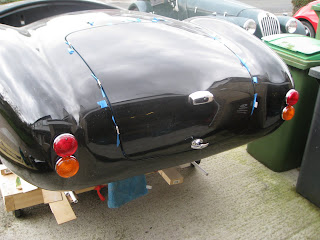Decided to tackle a few more holes this weekend. I'm kind of aiming to have all the drilling, filing, cutting and sanding finished whilst I can work outside. I'm sure we'll have a wonderful summer and there will be plenty of opportunities... but just in case, I'm getting them all done now. The other reason to push on with these is that there are still a few DIY jobs needing doing around the house and at the moment, I seem to be getting a bit of a free reign at weekends but it can't last forever. If I can get the messy outdoor Cobra related jobs finished now, I can do some of the less messy indoor stuff in the garage during the evenings and work on the ever increasing list of household DIY jobs at the weekend.
Making the most of my free pass, first job this weekend was to cut out the openings for the oil cooler and brake ducts. If you imagine these indentations as bowls, rather than cut the bottom out, I cut the bottom off. This leaves the cut edge facing backwards towards the car and out of sight rather than inwards towards the opening. My thanks to Steve (Shadow) for that tip.

First job was to mask the area, this enabled me to draw pencil around the cut line, hopefully making it easlier to see what I was doing.

Then, using the trusty Dremel, I cut all the way around the edge. It got a bit difficult to keep a smooth cutting line in the corners so I resorted to a few plunge cuts and then went back and joined them up.

I used exactly the same procedure on the cut outs for the brake ducts. Once it was all done, I used a file to neaten up the back edges, hopefully my earlier description now makes sense, and then rubbed them down with some wet 'n' dry to make it all smooth. One of the worst parts of doing this work is the dust produced. It's smelly, itchy and with tiny strands of glass fibre in it, you end up with tiny shards stuck in your skin that you just can't seem to wash away. Standard practise for all these jobs now is hat, goggles, face mask, boiler suit and latex gloves. As I go round completing odd jobs here and there, I'm also rubbing down all the edges of the underbody and the inside of panels I know I'm going to be working on later, just to try and keep the rough edges to a minimum.
Ta Daa... !

Next up were the screen demist vents. This is another area where GD kindly mark out the placement of holes to be drilled. Completing this job was a simple matter of drilling the pre-marked holes used to secure the escutcheons, masking the area, temporarily fitting the escutcheon plate and using a pencil to mark out the area to be cut. The escutcheon plates themselves are actually nice and shiny but wrapped in masking tape to protect them until they are finally needed.


I measured the width of the cut out to be 5mm and used a 4mm drill to drill a series of holes along the centreline. Then it was a simple matter of joining the holes with the Dremel (except the end ones.... think about it) and enlarging/finishing the slot with a file.

Once the drilling and filing was done, the original pencil line drawn on the masking tape wasn't very clear so I stripped off the old masking and applied a new piece and marked the slot again. Second time around was enough to mark and file the slot spot on

Repeat for the other side and another job complete. I understand the trick is to paint the inside of the slot matt black so it doesn't show once the escutcheon plates are bolted into position

Whilst the tools were out I also cut out this small panel from each side of the cockpit. I'll be honest and admit I can't actually remember what this cut out is for but it was marked to be cut out by GD so cut out it was! I used a strip of blue masking tape to emphasize the cut line which would be lost under the dust once I got going. The Dremel strikes again !

You can see to the left of the cut line in this next picture a nice scratch introduced by a wayward file, sadly, the result of sloppy workmanship and a "gung ho" atitude, it will probably polish out and from memory this whole area is covered by carpet so it won't really matter but it seemed as good a time as any to down tools and call it a day.






















































